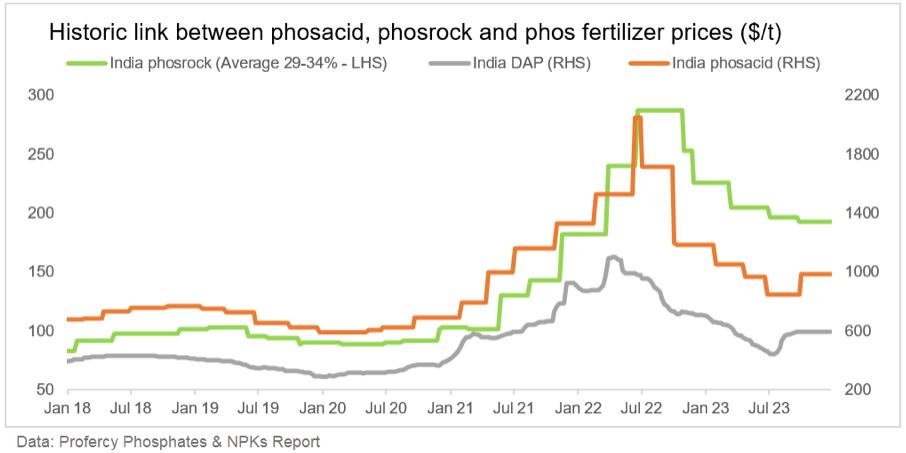Phosphate fertilizers are essential for bolstering the vitality of plants by providing them with a critical nutrient: phosphorus (P). This indispensable element plays a pivotal role in numerous physiological processes within plants, including photosynthesis, energy transfer, and root development. Without an adequate supply of phosphorus, plants exhibit stunted growth, reduced flowering, and diminished yields.
Phosphate rock, often abbreviated as “phos rock” or simply “phosphate,” is a naturally occurring mineral mined from geological deposits around the world. It is located at various depths, and extraction typically requires large dragline buckets, which scoop up the material for refinement. Phosphate rock is the primary raw material used in the production of phosphate fertilizers, such as diammonium phosphate (DAP), Monoammonium Phosphate (MAP), superphosphate and triple super phosphate (TSP), among others. These formulations differ in their phosphorus content and solubility, offering flexibility for farmers to choose the most suitable option based on soil conditions, crop requirements, and budgetary constraints.
One of the notable advantages of phosphate fertilizers lies in their long-term impact on soil fertility. Phosphorus has relatively low mobility in soil, meaning that once applied, it tends to remain accessible to plants for extended periods, thereby ensuring sustained nourishment throughout the crop’s lifecycle. This characteristic makes phosphate fertilizers key for enhancing soil fertility and promoting sustainable agricultural practices.
NPK fertilizers, named after their primary nutrient components – nitrogen (N), phosphorus (P), and potassium (K) – are valued for their role in providing a balanced nutritional regime to plants. While each of these nutrients serves distinct functions, their synergistic interaction is crucial for maximizing crop productivity and quality. Nitrogen (N), fuels vegetative growth and chlorophyll production, thereby enhancing leaf development and overall plant life. Phosphorus (P), stimulates root growth and flowering, facilitating robust reproductive processes. Potassium (K), the third essential nutrient, contributes to numerous physiological functions, including water uptake, enzyme activation, and disease resistance, thus fortifying plants against environmental stressors.
NPK fertilizers are available in various formulations, each tailored to meet the specific nutrient requirements of different crops and growth stages. Whether in the form of compound fertilizers, blending multiple nutrients into a single product, or as complex fertilizers, integrating micronutrients alongside the primary NPK trio, these formulations offer farmers a comprehensive solution to address diverse agricultural needs effectively.
The largest phosphate fertilizer, phosphoric acid and phosphate rock producers include: OCP (Morocco), Ma’aden & Sabic (Saudi Arabia), PhosAgro, EuroChem, UralChem & Acron (Russia), YUC, GPCG & Yihua (China), Mosaic & Nutrien (North America), JPMC (Jordan), GCT (Tunisia) and Somiphos (Algeria).
Global phosphate fertilizer prices are defined by a number of factors, principally demand and supply. Demand is a function of affordability, either against international key crop prices or, in the case of a number of key markets including China and India, based on the level of government subsidies. Demand can also be influenced by major weather patterns like India’s monsoon or the global El Nino phenomenon, along with the level of carryover phosphate fertilizer stocks. Furthermore, product switching can define demand for P2O5 use as often in cases of high DAP/MAP prices farmers choose to switch to discounted SSP/TSP or lower analysis NPKs.
Supply factors include capacity additions and production plans at key suppliers, for instance the ongoing large scale capacity additions in Morocco/Saudi Arabia. This can be offset by export controls in China, which over recent years have cutback Chinese phosphate fertilizer supply from international markets due mainly to protectionist policies. Weather also plays a role in supply, with hurricanes and high swell sometimes influencing supply on both sides of the Atlantic. Certain markets are also influenced by trade tariffs and duties, including the US market which has strong duty controls against Chinese, Moroccan and Russian supply. Production costs are also relevant to supply (particularly the costs of phosphoric acid, phosphate rock, ammonia, sulphur and sulphuric acid).


